Even though humans and dogs have co-evolved together, living in a modern human-dominated world can cause significant stress for our canine companions. Much of this stress can be resolved through understanding how to best meet the needs of our domesticated dogs. A foundational step is being able to recognize stress in dogs as many signals can go unnoticed by the untrained eye.
In this guide, we’ll discuss a non-exhaustive list of 12 signs of stress in dogs, how to recognize these signs, offer perspective on why your pup may feel stressed, and provide some tips for helping your pups feel safer, happier, and healthier. For this article, we’ll be talking about signs of distress in dogs. In other words, we’ll focus on stressful stimuli that are perceived by the dog as negative. This is in comparison with eustress, which is stressful stimuli that are perceived as positive and can lead to growth.
Note that while we’ll discuss each sign individually, it’s common to see these signals occur together. Additionally, if you notice a sudden, concerning behavior change in your canine companion, it’s always a good idea to set up a thorough vet check for possible underlying medical conditions. Finally, it’s important to not look at these signals in a vacuum as they can hold various meanings. The body language of dogs is complicated and context is incredibly important.
Read on to learn more.
1. Yawning

In dogs, yawning can be a sign of stress and a signal of appeasement or discomfort. In this photo, this dog is likely yawning because they are quite uncomfortable with the proximity and intensity of this social interaction. ©Jose carlos Cerdeno/iStock via Getty Images
If you notice that your dog is yawning, it’s important to assess the environment and other signals from your pup. While yawning can be a sign of tiredness or boredom, dogs will also yawn as a sign of stress. For example, many dogs will yawn when tightly hugged, kissed on the face, leaned over, stared at, etc. While some pups may not mind or enjoy being hugged, kissed, or petted on the head by humans, the truth is that plenty of dogs don’t, especially when directed around their neck or at their face. But, because we see these behaviors as offering affection, it can be difficult to recognize when a dog would actually much prefer a different interaction.
2. Signs of Stress in Dogs: Panting

If you notice your dog panting outside the context of heat or exercise, they may be showing signs of stress. ©Patrick H/Shutterstock.com
You may notice that your dog pants even though they aren’t hot or haven’t been exercising. Certain medical conditions, medications, and pain cause also cause panting. However, your dog may also pant because they are feeling stressed, either from or in the absence of the causes mentioned above.
Stress panting typically happens when your pet is feeling acutely scared or painful. You may see this with some dogs during car rides, at the vet, and during thunderstorms and fireworks. Typically the panting is intense and the dog will hold their mouth wide open. This sign is often accompanied by several other signals listed further in this article.
3. Cowering/Hiding
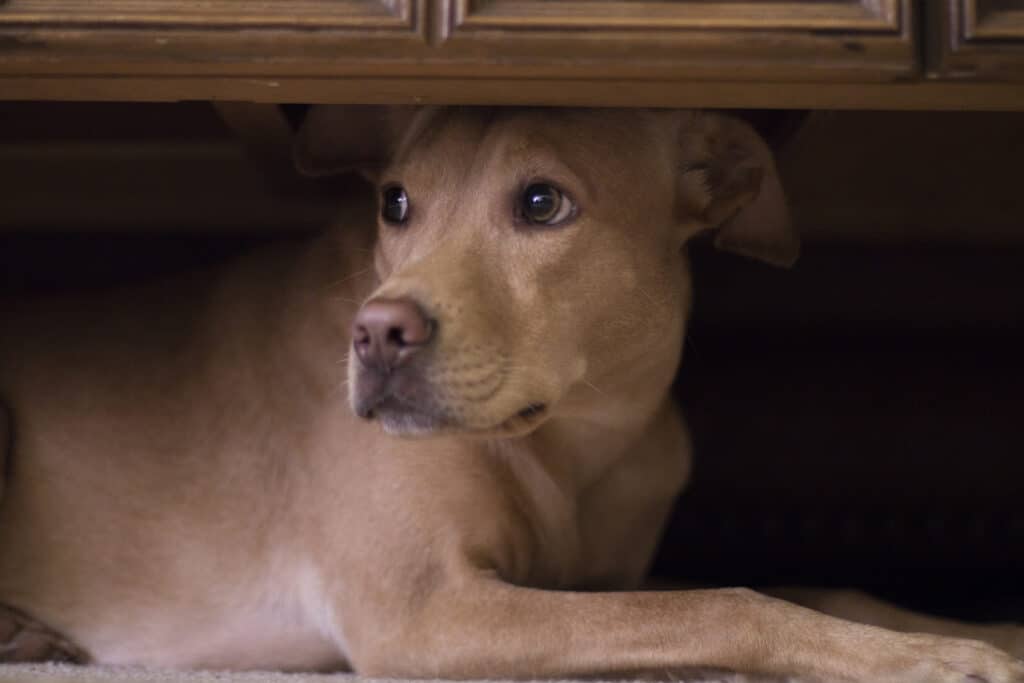
Hiding or cowering are more obvious signs of stress in dogs. ©Patrick H/Shutterstock.com
A more obvious sign of stress in your dog is cowering or hiding. Your dog may display this during an acutely stressful event or they may chronically hide. Both can be signs of a dog who needs support. Especially for a dog who is chronically hiding, it’s important to set up a thorough vet check as pain and underlying medical conditions can cause many of the same signs that non-painful stress can.
Your dog may also be hiding or cowering because they feel trapped. Without realizing it, someone may be inadvertently cornering the dog. It can be especially easy for children, who often lack detailed spatial awareness, to accidentally corner a dog or cause them to cower by using loud voices and jarring body movements.
4. Signs of Stress In Dogs: Whale Eyes

When stressed dogs exhibit whale eyes, you’ll notice the eyes are wide and you can see more of the sclera (whites of the eye) than normal. ©GlobalP/iStock via Getty Images
Often, when a dog is feeling acutely stressed, especially if the event lasts for more than a few seconds, you may notice their eyes appear wide. You can typically see the whites of their eyes. In response to another dog, your pup may exhibit whale eyes along with turning their head to signal appeasement. If they are feeling stressed or intimidated by another dog, your pup may use this signal along with a head turn to communicate that they aren’t a threat and don’t want conflict.
5. Tongue Flicks

Many, but not all, dogs do not enjoy having their face held close to a person’s, especially in the manner seen above with hands pulling the dog’s head. In response, you may notice the dog give a short lick. ©Magui-rfajardo/iStock via Getty Images
Of course, dogs lick for many reasons. However, short, tight, and quick licks are often a sign of stress or an attempt to appease. This type of licking is often called tongue flicking. You can find a plethora of videos online of dogs quickly licking a person’s face after someone has leaned into the dog’s space.
While the video may describe this as a sign of happiness and affection from the dog, it’s much more likely that the dog is actually stressed. This specific type of licking is typically a request for space and an appeasement signal to de-escalate a stressful situation. Many dogs do not appreciate when people put their faces next to their heads and they give a quick, tight, lick in an attempt to communicate this. You may also notice the dog yawn or display whale eyes and head-turning during this as well.
6. Signs of Stress in Dogs: Trembling

When acutely stressed, you may notice your dog trembling. ©Astakhova/iStock via Getty Images
Another more obvious sign of stress in dogs is trembling. This is commonly seen in dogs experiencing acutely stressful events in which they are also quite afraid. Dogs with sound phobias will often tremble in response to the scary stimuli. Of course, dogs also tremble when they are cold, so it’s always important to assess the larger picture, including the physical environment when reading your dog’s body language.
7. Displacement Behaviors
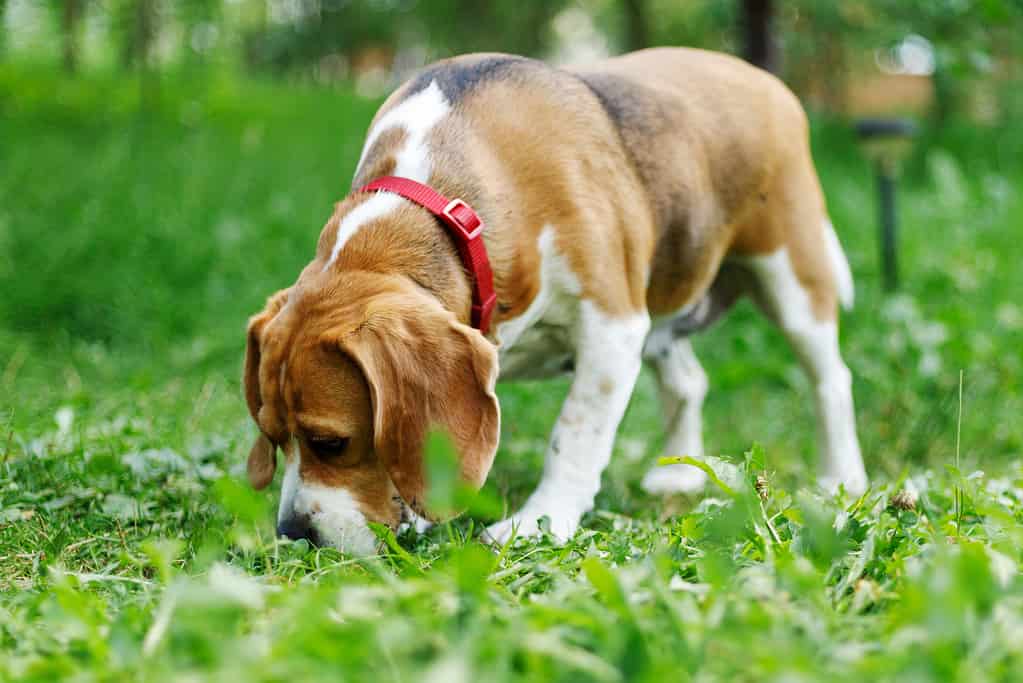
If you notice your dog suddenly sniffing out of context, especially in the midst of a potentially uncomfortable environment, this may be a displacement behavior. ©Andrii Zastrozhnov/iStock via Getty Images
Displacement behaviors refer to out-of-context behaviors typically performed when an individual is feeling conflicted. This conflict may cause only minimal or substantial stress. For dogs, this often manifests as sniffing, scratching, yawning, body shakes, and stretching.
As an example, your dog may start suddenly sniffing the ground when approached by another dog. This can indicate that your dog feels conflicted, and perhaps stressed, over this approach. They may not know how to proceed, and so they default to a comfortable behavior, perhaps while processing the situation. These signals can also be meant as appeasement gestures. Many dogs display body shakes and stretching when play gets too rough. This helps communicate that the intensity is too high and that the dog doesn’t want any conflict. Ideally, the other dog will read this signal and calm the play down a notch or two.
8. Signs of Stress in Dogs: Taking Treats Quickly and Roughly
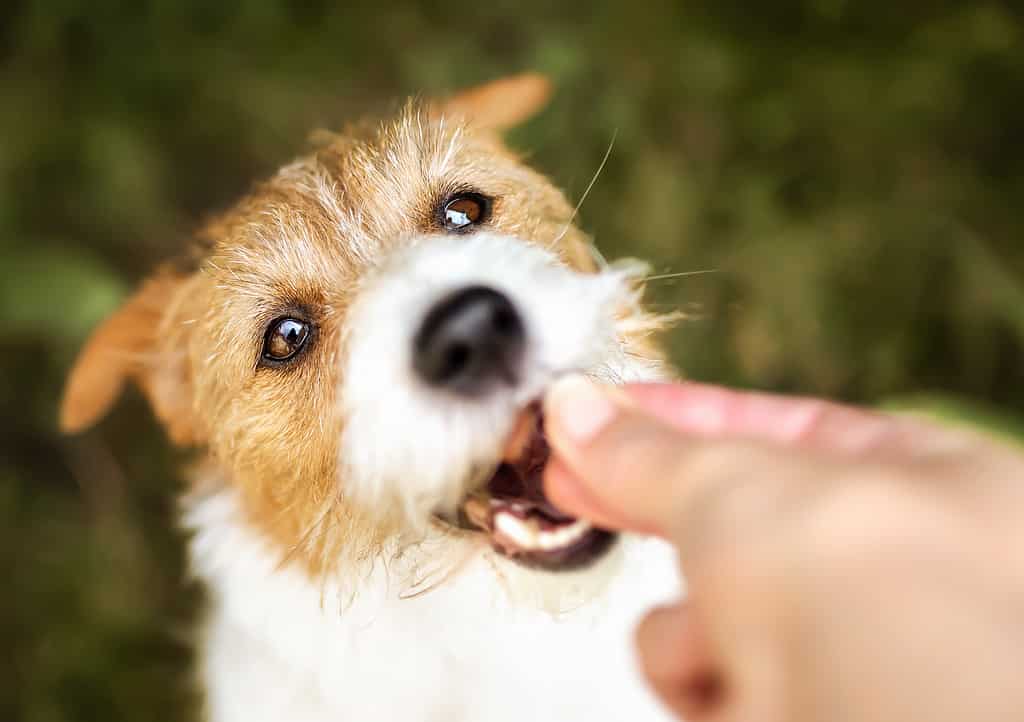
If your dog is uncharacteristically snatching treats, especially in a novel or potentially overwhelming environment, this can indicate stress. ©Wavetop/iStock via Getty Images
You may have a snappigator pup who always excitedly snatches treats from your hand. They may simply need to learn a gentle method of taking treats. You can teach this by holding the treat in your fist and opening it when your dog licks between your pointer finger and thumb to try to get the treat. However, if your dog typically takes treats gently, but starts snatching them in certain environments, this can be a sign of stress.
You may be using treats as part of a “look at that” counter-conditioning session with a dog who feels anxious around other pups. The goal of these sessions is to set them up so your dog is exposed to the stimulus at a distance where they feel comfortable. If your dog looks at the other dog when you cue them to but uncharacteristically quickly snatches the treat from your hand after you mark the behavior, it’s a strong indicator that your dog is still feeling quite stressed in the environment.
9. Head Turns

You may notice your dog turning their head away as a sign of stress, especially in an environment they can’t easily remove themself from. ©Ирина Мещерякова/iStock via Getty Images
If your dog is feeling stressed in a situation in which they can’t easily leave, you’ll often see them turning their head away from the source of the stress. This may look like your dog turning away from an unfamiliar child sitting too closely next to them on the couch. Or, they may keep their head turned away from a vet during a stressful exam. Head turns can also signal to another dog that they don’t want conflict and is a way of deescalating a situation. This is because dogs often stare at each other before escalating to a physical confrontation.
10. Signs of Stress in Dogs: Self-Harm Behaviors
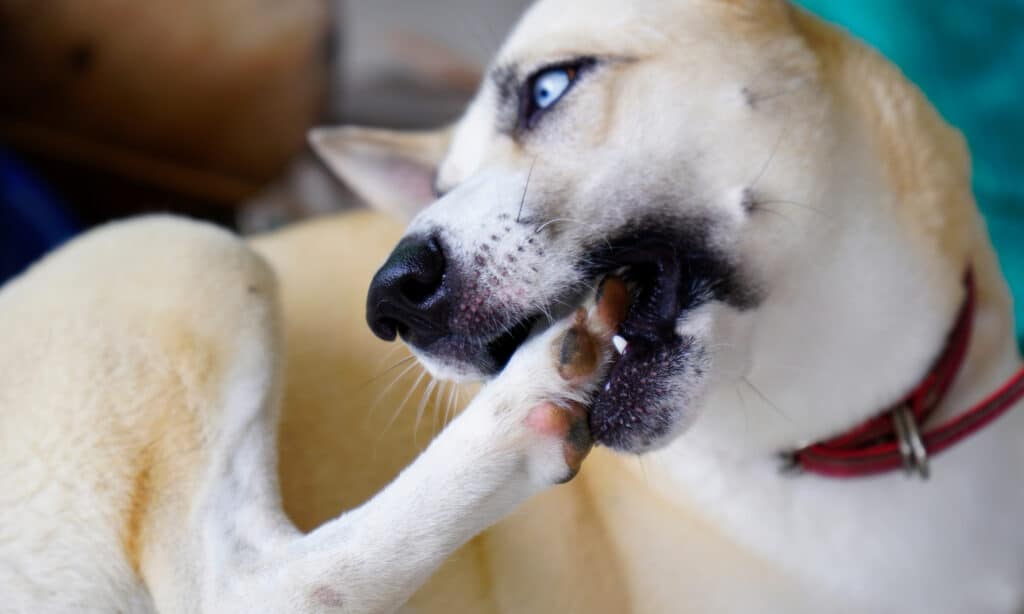
Consistently, repeatedly, and intensely chewing feet can be a sign of stress, the cause of which may include an underlying medical condition. ©KPhrom/Shutterstock.com
For chronically stressed dogs, you may notice the development of alarming, self-harm behaviors. These behaviors can include licking their feet raw, chewing their tails, overgrooming, and flank biting or sucking. These actions can repeat with such intensity that the affected areas may be raw and bloody, leading to chronic pain and infection risk.
These signs are particularly indicative of maladaptive, chronic stress. Underlying medical conditions may play a role in chronic self-harm. You might also see this type of behavior in dogs who are repeatedly stuck in situations without relief, such as kenneling every day for many hours or with dogs who are chronically chained.
11. Drooling
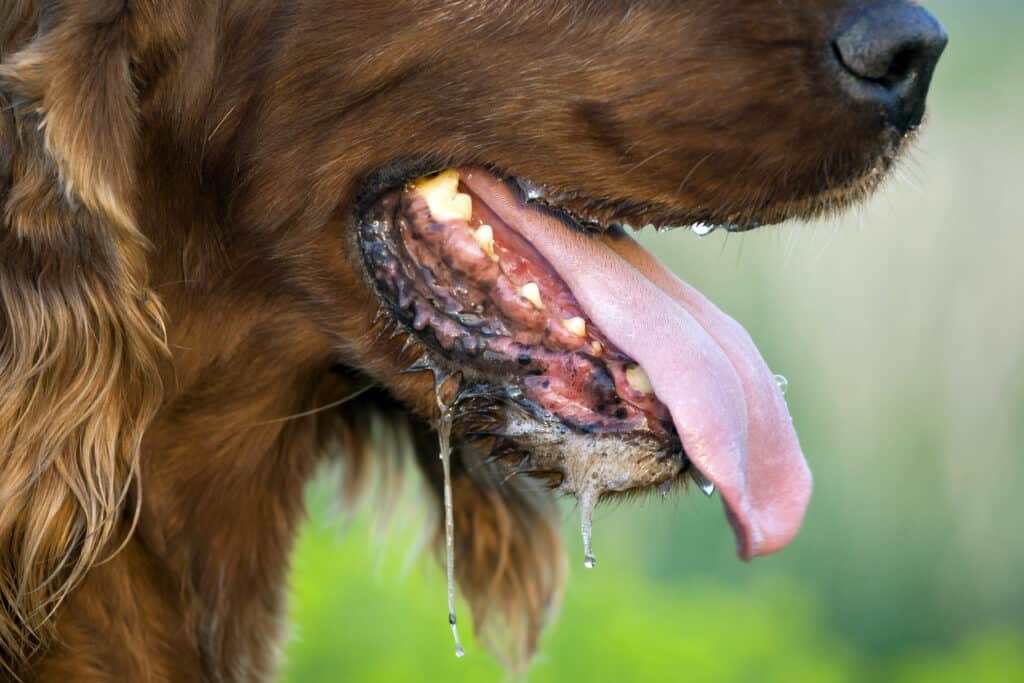
During acutely stressful events, such as a scary car trip, your dog may drool. ©Reddogs/Shutterstock.com
While your pup may drool in anticipation of their favorite meal or in response to a powerful smell, they can also drool as a sign of stress. This sign is often accompanied by wide eyes, trembling, and excessive panting. Dogs who are afraid of riding in cars often drool in vehicles as a sign of stress. These dogs may also become quite nauseous.
12. Signs of Stress in Dogs: Abnormal, Repetitive Behaviors
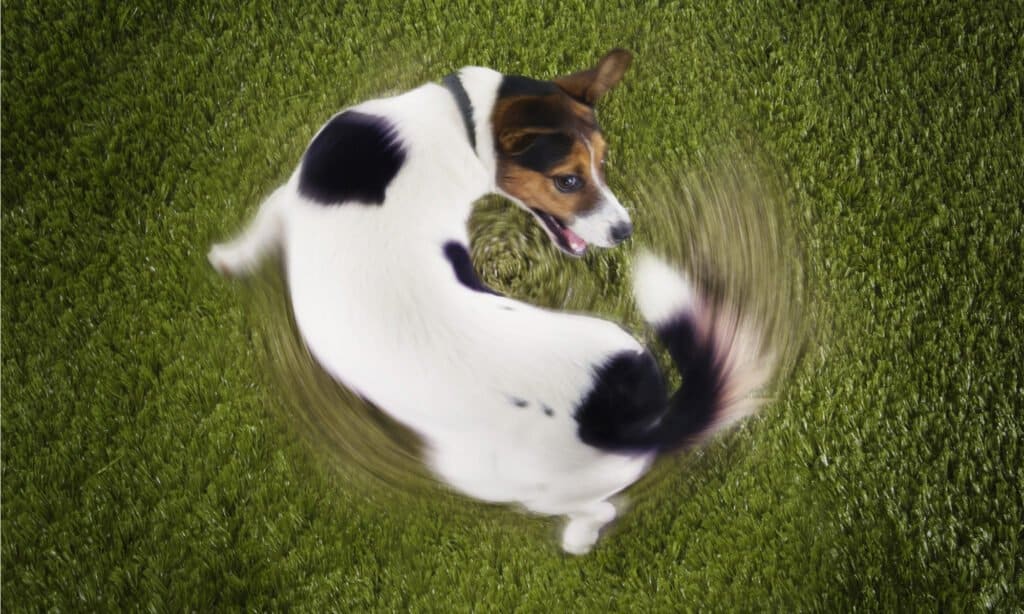
Repetitive tail-chasing that is difficult to interrupt or distract from, and interferes with normal life, may be an abnormal, repetitive behavior indicative of stress. ©sirtravelalot/Shutterstock.com
These signs are similar to, and may overlap with, self-harming behaviors. With abnormal, repetitive behaviors you may notice that your dog is displaying behaviors such as frequently chasing their tail, pacing, fly biting, shadow or light chasing, spinning, and hallucinatory prey chasing. These behaviors occur frequently, repetitively, and out of context. They may be a result of coping mechanisms due to chronic stress or an underlying health condition including mental health. Unlike the occasional fixation or response to exciting stimuli, these behaviors are very difficult to interrupt for long durations and interfere with daily routines and normal activities such as eating and resting.
Signs of Stress in Dogs: How to Help

Knowing how to help your dog is crucial when they’re exhibiting signs of stress. ©iStock.com/Albina Gavrilovic
Knowing the potential signs that your dog may be feeling stressed is one of the first steps in helping resolve the issue. After that, you’ll want to observe the larger picture and start asking why your dog may be stressed. The answer can be simple or quite complex.
Make Observations
For example, if you notice your dog yawning, especially if the yawn is intense, long, and paired with a high-pitched whining sound, it’s best to take a step back and ask yourself what the immediate triggers could be. Perhaps they are in an environment that is overwhelming or they are stressed by a child hugging them.
Or, you may notice that your dog always starts sniffing the ground during a particular part of your training session. In that case, you may want to think about what part of the training could be causing stress or conflict.
Some people find it helpful to write down their observations to help notice patterns associated with the stress signals.
Reduce, Remove, and Avoid Triggers
Sometimes, the best course of action is to try to remove the source of stress or remove your dog from the trigger. For example, they may exhibit whale eyes and head turning when near other animals or people while eating. To help resolve the stress, you can make sure to feed them separately in an area where they are comfortable and won’t be bothered.
If you’re trying to introduce your dog to a new dog park, for example, and they exhibit the above signs, it may be a good idea to walk out of the fenced-in area and let your dog process the environment first from a more comfortable distance. Or, you may want to try coming back when fewer dogs are present. You could even go in once the park is empty and let your pup scent process without other dogs around.
Advocate for Your Dog
Humans often inadvertently stress dogs out. By advocating for your dog in social interactions, you can reduce or resolve acute instances of stress. This may look like asking other people to not pet them on the head or pull them into a hug. If your dog is generally comfortable with greeting strangers, you can ask them to scratch your dog’s chest instead of a head pat. Or, ask that they refrain from petting your dog, and simply allow them to say hello through body language and sniffing.
It can be difficult to say no when someone asks to pet your dog, but we must be their protectors and advocates. If you know your dog isn’t comfortable with being pet by strangers, it’s important to kindly but firmly set boundaries. You can also help your dog feel more comfortable around strangers by giving them pieces of high-value treats whenever they’re around someone new. However, it’s best to practice this at distances from strangers in which your dog feels comfortable. You don’t want to use treats to lure or coerce your pup into approaching people.
Reach Out for Help
If you can, try to remove your dog from the acutely stressful environment. This may not be possible, such as during a thunderstorm or necessary vet appointment. In this case, especially if the stressful event occurs again or is part of a normal routine, you’ll want to take steps to help your dog feel less afraid in those situations. Especially in these cases, it’s best to reach out to a force-free behaviorist or veterinary behaviorist for assistance.
Your vet may prescribe anti-anxiety medication or supportive supplements. Alongside this, a force-free behaviorist can create a step-by-step plan to help your pup feel safer in the triggering environments. Typically, these processes take many months and require compassion and moving incrementally. Especially in the case of phobias and trauma, it’s crucial to move at the pace of your dog’s comfort.
Comfort Them
Some trainers and pet websites may discourage you from comforting your dog when they are stressed or frightened. The idea behind this is that you are reinforcing these “negative” emotions by paying attention to them. However, this claim is not based on a scientific understanding of emotions, behavior, or reinforcement. You won’t make your dog feel more afraid by offering them comfort, and reinforcement works in relation to the increase or decrease of behaviors, not emotions.
By comforting your dog when they are stressed, you can help them recognize you as a base of support. This can help them feel less alone in stressful situations and thus less likely to feel like they need to defend themself through aggression or flight. If your dog knows they can lean against your leg or sit in your lap when afraid, you’ve offered a repeatable, safe action they can take when scared or stressed. Of course, comforting shouldn’t replace trigger reduction and removal.
Assess and Provide for Species-Specific Needs
A hugely important part of assessing stress in dogs is determining if their species-specific needs are being regularly met. For dogs who experience chronic stress, there may be a necessary component of their doggy life that is missing or underrepresented. If you notice that your dog seems frequently stressed, you may want to evaluate if they routinely have access to the following:
- The ability to express discomfort without punishment and to have reasonable boundaries respected (ex. don’t bother the dog when eating or force them to be petted if uncomfortable).
- Voluntary, fear-free exercise.
- Comfortable shelter that they can freely come and go from.
- Social companionship (for some dogs, this may include friendships with other dogs, or it may not).
- Rewarding, cognitive and food-based enrichment (such as puzzles that provide treats when solved).
- Scent-based enrichment.
- Appropriate items to chew.
- Free-form or structured play.
- For adult dogs, at least 12 hours of restful, restorative sleep.
- Nutritious food.
- Clean, fresh water.
- Freedom from pain or consistent pain management.
- Freedom from fear, coercion, pain, and punishment-based training.
- Freedom from chronic conflict (is there multi-dog conflict occurring in the house?).
- Freedom of movement and choice, as much as safely possible (such as allowing them to follow their nose on walks in the forest, when possible).
Sharks, lions, alligators, and more! Don’t miss today’s latest and most exciting animal news. Click here to access the A-Z Animals profile page and be sure to hit the Follow button here or at the top of this article!
Have feedback? Add a comment below!
Up Next:
-
Fix water crisis, or else, City warned
-
Giving Tuesday: How to donate to a charity with purpose and intention
-
Visiting South Korea? Get your culture fix in this artsy street in Seoul
-
Traffic advisory issued ahead of PM Modi's Hyderabad roadshow today
-
How to improve teaching of English in primary schools
-
How to deep clean a small bedroom according to experts
-
Now you know how tough being in govt is, Puad tells PKR
-
How to make a Hummer even flashier: strap a Rolls-Royce on top
-
How to crack the zodiac code: Use your birth date to understand yourself better
-
Ravens vs. Chargers Sunday Night Football live updates: Odds, predictions, how to watch
-
How To Watch The 2023 BET Soul Train Awards
-
Stimulus Check for Senior Citizens: How to qualify for a $2000 payment?
-
How to watch Faraway Downs: stream the Baz Luhrmann miniseries
-
How to Watch Today's Cleveland Browns vs. Denver Broncos Game: Start Time, Livestream Options
